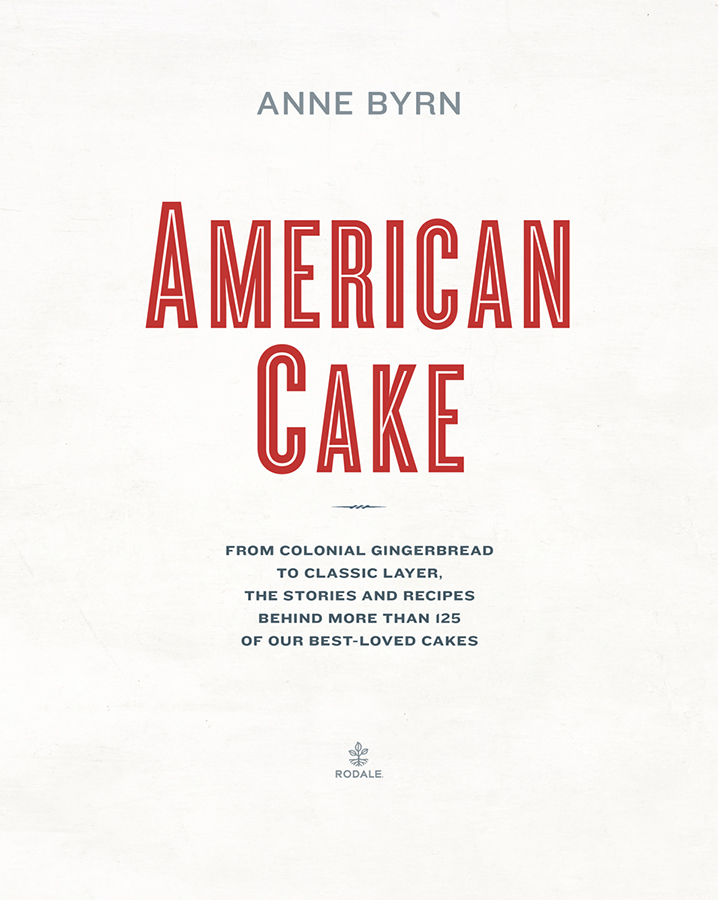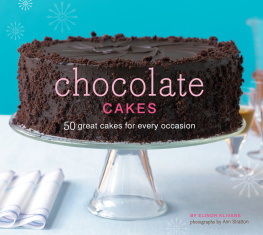

Mention of specific companies, organizations, or authorities in this book does not imply endorsement by the author or publisher, nor does mention of specific companies, organizations, or authorities imply that they endorse this book, its author, or the publisher.
Internet addresses and telephone numbers given in this book were accurate at the time it went to press.
2016 by Anne Byrn
Photographs 2016 by Rodale Inc.
Author photo Ashley Hybert
All rights reserved. No part of this publication may be reproduced or transmitted in any form or by any means, electronic or mechanical, including photocopying, recording, or any other information storage and retrieval system, without the written permission of the publisher.
Bake-Off is a registered trademark of the Pillsbury Company.
The following pages listed refer to the print edition of this book. Front cover recipes: (top) Pink Champagne Cake ()
Book design by Amy C. King
Photographs by Mitch Mandel / Rodale Images
Food Styling by Paul Grimes
Prop styling by Carla Gonzalez-Hart
Library of Congress Cataloging-in-Publication Data is on file with the publisher.
ISBN 9781623365431 hardcover
ISBN 978-1-62336-544-8 ebook

We inspire health, healing, happiness, and love in the world. Starting with you.
RodaleWellness.com


Contents
INTRODUCTION:
THE HISTORY OF CAKE IN AMERICA

Introduction
THE HISTORY OF CAKE IN AMERICA
The first American cake wasnt sweet, wasnt frosted, wasnt grand. It was more like a johnnycake or hoe cake, based on cornmeal and cooked on a griddle. What a far cry that seems from the grand cakes of todaythe triple-tiered, chocolate-frosted, and candle-covered confections we look forward to on birthdays and other celebrations.
Cakes have become an icon of American culture and a window to understanding ourselves. Be they vanilla, lemon, ginger, chocolate, cinnamon, boozy, Bundt, layered, marbled, even topped with meringuethey are etched in our psyche. Cakes relate to our lives, heritage, and hometowns.
But why cake? And what role does cake baking play in our countrys history? These are questions I have wondered all my life as cake has been my passion, obsession, and occupation. I have baked cakes for my family and friends ever since I was tall enough to reach the box of Hersheys cocoa. I baked the classic French genoise and dainty madeleines at cooking school in Paris. And as a newspaper journalist, I have researched the best flours for baking, the best methods for mixing the batter, and the best frosting recipes because these were things that helped my readers bake better cakes.
I have wondered why devils food cake is not red in color, how the Southern delicacy known as ? Were these now-legendary recipe mishaps the result of a lapse of memory, frugality, or being too lazy to run to the store for more flour?
I could taste the lemon and almond in Mashulas Coconut Cake as I read Eudora Weltys Delta Wedding and smell the bourbon-filled .
The recipe for American cake looks something like thisone part technique and history from a homeland, one part available ingredients, and one part American spirit. According to historian Daniel Boorstin, what made Americans who they were was not what they sought but what they accomplished. America accomplished much as a young nation, and in the American kitchen, the cooksbe they Pennsylvania Dutch, French, English, African, Irish, Polish, Russian, Italian, or Scandinaviancontributed the ideas, techniques, inventions, spark, spirit, and history that crumb by crumb made American cake. The beautifully diverse and resourceful community of cooks who first baked American cake worked off-script, improvising their family recipes with ingredients at hand. But in regions of diversity, such as North Carolina, Texas, Kentucky, and Pennsylvania, a blending of cultures and styles of baking occurred. Neighborliness and community building were key components of survival in early America. It went well beyond borrowing a cup of sugar. If you didnt help out your neighbor, hard weather or attacks by Indians or animals threatened your existence. People were dependent on each other, which reinforced a generosity of spirit, and that spirit was evident at quilting bees, barn raisings, church socials, and other good excuses to share cake, coffee, and a recipe.
With the founding of the new country came patriotism, the mother in the home, the great migration west, emigration from Europe, the rise of the middle class, better ingredients, appliances, cooking schools, and inventions like baking powder that made baking cake faster and less expensive, needing fewer eggs. But war and depression resulted in lean years and also a new creativity on how to bake with limited resources. Postwar years brought the baby boom, Bake-Offs, Tupperware, women in the workforce, the rise of commercial bakeries, and an eye on convenience. And yet cake never left the spotlight. According to historian Laura Shapiro, cake had a grip on the heart that bread simply couldnt match.
Cake has certainly had a hold on America. Todays American cake is still baked, frosted, and decorated at home. We might be baking with eggs from our backyard hens, and our cakes are more natural, possibly organic, maybe flourless or gluten-free, or an update of a classic cake, such as a red velvet cake, but calling for beets to tint it red. Weve come a long way.
And what a delicious coast-to-coast journey it has been. Through this book, you will travel with me and savor our nations history of cake baking through contemporary eyes. From the dark, moist gingerbread of New England, to the elegant English-style pound cake of Virginia, to the hardscrabble apple stack cake of Appalachia (, to the more modern California cakes of almond or orange. For today in midwestern kitchens a caramel icing is still stirred over the stove and poured onto hearty cakes of applesauce or mincemeat. And in the upper Midwest and Pacific Northwest, families still bake the Bundt cakes, German meringue cakes, and Scandinavian coffee cakes passed down from their ancestors.
American cake lets us look into the world from which we came and the one we inhabit today. It is synonymous with celebrations and happy times, just as it was when our nation was young. So crack the eggs, sift the flour, and set the oven. The diverse, delicious, and fascinating story of cake in America begins.

















